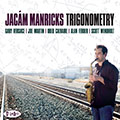Great Album, Bad Name
July 8, 2010
http://lucidculture.wordpress.com
Trigonometry. Just the word alone makes you shake your head. Seriously – how many of you remember any of that stuff? That’s the title of composer/alto saxophonist Jacam Manricks’ new album – and you mustn’t let it scare you off. Manricks vaulted into the uppermost echelon of jazz composers with his lushly orchestrated big band masterpiece, Labyrinth, last year. This one reduces the forty-piece orchestra to just a sextet, with hardly any loss of volume, trading sweep and majesty for melody, terseness and a jazz vibe that’s considerably more classic than classical. In addition to new compositions, there are three intriguingly rearranged cuts from Labyrinth here, along with an imperturbably fluttering cover of Eric Dolphy’s Miss Ann. Manricks – who steps out much more here than he did on Labyrinth, with great success – joins a cast that includes pianist Gary Versace, bassist Joe Martin, drummer Obed Calvaire, trombonist Alan Ferber and trumpeter Scott Wendholt.
The title track takes a funky late 70s Weather Report style riff and makes it purist and retro, Manricks buoyant against Calvaire’s aggression, then more expansive later on. The tongue-in-cheek Cluster Funk builds from similar riffage to a modally-charged simmer, Wenholdt and then Manricks bracingly warping in and out. Slippery, the third track, is a swing number: the sax pushes against the blues, against terse block chords from Versace, and the blues push back. And finally Manricks lets them in
Nucleus makes a big beautiful golden-age style ensemble piece out of a vivid latin-tinged melody a la late 50s Miles, followed by the pulsing, shapeshifting, aptly titled Sketch. The best song on the album, Mood Swing is a deliciously ominous, modal nocturne with masterful touches from Versace at the uppermost registers, echoed at the opposite end from Calvaire against distantly menacing sax. Versace really takes hold and owns this one, from his glimmery, insistent, deceptive chordal work (very Neil Shah-style), to an expressionistic solo. The stripped-down version of Labyrinth here shares that same eerie prismatic glow, Versace’s ultraviolet ambience again the highlight. Of the two final Labyrinthine tunes, Combat downplays the heavy Ravel influence of the orchestrated version in favor of wistful bluesy tints; Micro-Gravity, on the other hand, reaches for the Catalan majesty of the original and hits a bullseye. Yet another great new album from the Posi-Tone label. Manricks plays the cd release show on July 30 at the Cornelia St. Cafe at 10:30 PM.
